Content
- 1 Tulip variety 'Gavota'
- 2 Tulip cultivar 'Recreado'
- 3 Tulip cultivar 'Olaf'
- 4 Tulip variety 'New Design'
- 5 Tulip cultivar 'Madame Spoors'
- 6 Tulip cultivar 'Happy Generation'
- 7 Tulip cultivar 'Lustige Witwe'
- 8 Tulip variety 'Alexander Puschkin'
- 9 Tulip variety 'Mascara'
- 10 Tulip cultivar 'Cancun'
- 11 Tulip cultivar 'Madame Curie'
- 12 Tulip variety 'Snowboard'
- 13 Tulip variety 'Grandma's fairy tales'
- 14 Tulip cultivar 'Orlenda'
- 15 Tulip 'Staning Apricot' cultivar
- 16 Tulip cultivar 'Anne Claire'
- 17 Tulip cultivar 'Preludium'
- 18 Tulip cultivar 'Tamara'
- 19 Tulip cultivar 'Emmy Peeck'
- 20 Tulip variety 'Pearl'
- 21 The nuances of tulip culture
- 22 Application
- 23 Tulip varieties - New Dutch
- 24 Ideal for forcing varieties - Darwin hybrids and Triumph
- 25 Fringed tulips
- 26 Double tulips - early and late varieties
- 27 Low-growing tulips or dwarf
- 28 Apricot Parrot
- 29 Blue Diamond
- 30 Blue Heron
- 31 Brigitta (Brigitta, Brigitte)
- 32 Gander's Rhapsody
- 33 Hamilton (Hamilton)
- 34 Hemisphere
- 35 Lucky Strike
- 36 Madison Garden
- 37 White Elegance
Garden-class tulips Triumph were bred at the beginning of the 20th century by crossing varieties of the Darwin hybrids and Prostnye Early classes. They are very much loved by both gardeners-breeders working with them, and summer residents who have been successfully growing for more than one year and more than one variety in their area. Triumph tulips still proudly continue their solemn procession, today they are the most representative garden class: their assortment makes up 25% of the entire world assortment of this flower culture.
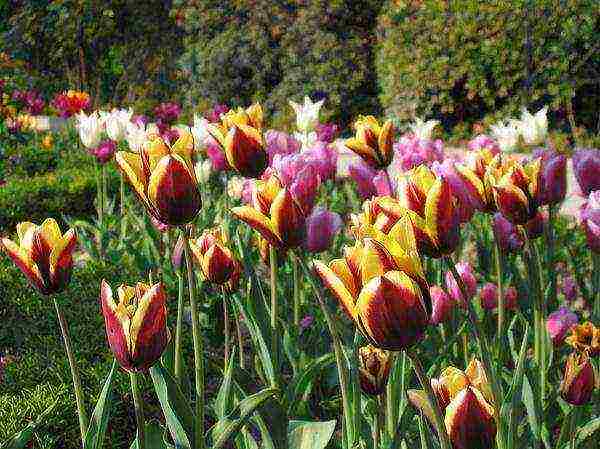
Tulips Triumph in bloom, in the foreground the variety Gavota
Tulips of this class are characterized by large goblet flowers, rather tall (40-70 cm) strong peduncles and a good reproductive rate. The color of the flowers is very diverse: from pure white to dark purple. They bloom for quite a long time, starting from mid-April - early May, they keep the shape of the glass well.
Tulip variety 'Gavota'
A bicolor variety created in 1961.
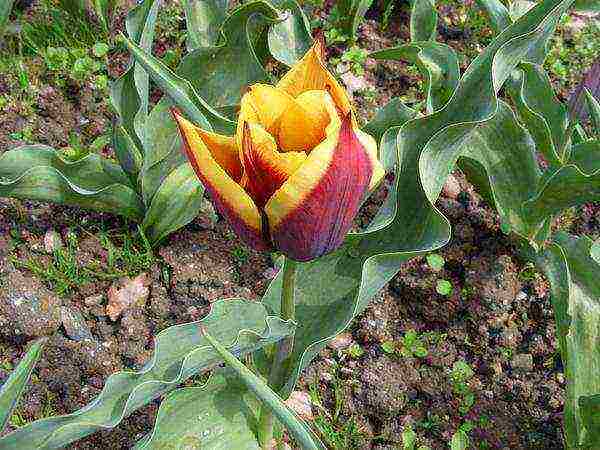
Tulip Gavota cultivar Plant up to 40 cm high, sturdy stem. Cup-shaped flower up to 8 cm high, purple-brown, with a light yellow border along the edge of pointed petals; blooms * from the second decade of April and blooms for 10 days. Resistant to diseases and unfavorable environmental factors, can be affected by the variegated virus. Effective in the foreground of flower beds, suitable for forcing from January to March inclusive.
Tulip cultivar 'Recreado'
A mysterious strain created by Visser in 1979.

Tulip Recreado cultivar, photo A. Papkov Plant 30 cm high, sturdy peduncle. The flower is goblet, up to 8 cm high, dark purple. It blooms in 2-3 decades of April, duration - up to 10 days. Resistant to unfavorable weather conditions, can be affected by fusarium and variegation virus. Suitable for spring flower beds, which brings mystery and sophistication. Well worth the cut.
Tulip cultivar 'Olaf'
This ruby red tulip was created in 1930.

Tulip Olaf grade It is low - up to 30 cm; the goblet flower is large, up to 9 cm high. It begins its bright flowering from the second decade of April, flowering lasts up to 20 days. It is resistant, but can be affected by variegation virus and fusarium.
Tulip variety 'New Design'
A very spectacular variegated variety bred by Toll in 1974.
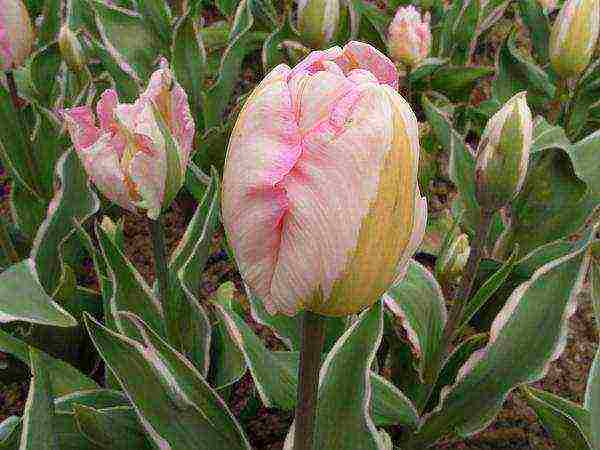
Tulip cultivar New Design The tulip is not very tall (about 20-30 cm), the stem is strong, the edges of the leaves are bordered by a pink-white stripe. The flower is goblet, up to 9 cm high, white, with a wide pink border along the edge of the petals. It blooms from the 3rd decade of April, not for long (up to 10 days). Resistant to diseases and adverse weather conditions. Interesting in the foreground of spring mixborders, suitable for cutting and early spring (in March) forcing.
Tulip cultivar 'Madame Spoors'
Those who love variegated tulips (not to be confused with variegated tulips) should definitely take a look at this strain, created by Sandberger in 1985.
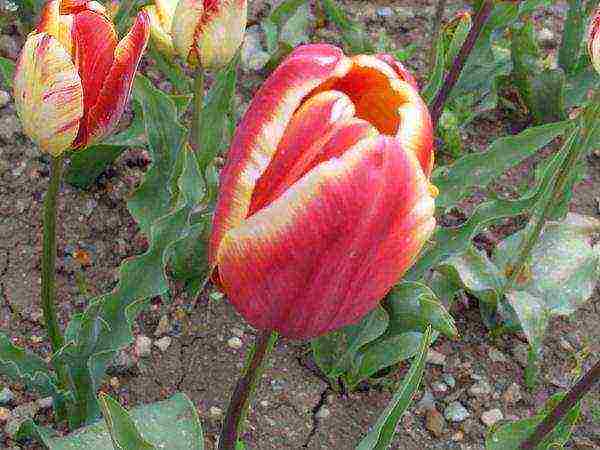
Tulip grade Madame Spoors Grade 45 cm high, sturdy stem. The flower is goblet, up to 9 cm high, dark crimson red, with a light yellow stripe along the edge of the petals. It blooms for 10 days, starting from the 2nd decade of April. Resistant to diseases and adverse weather conditions. Good for cutting and winter-spring forcing (from January to March inclusive).
Tulip cultivar 'Happy Generation'
An exquisite variety bred in 1969.
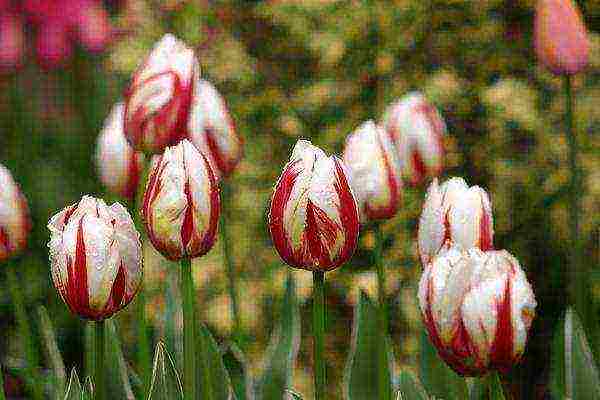
Tulip cultivar Happy Generation, photo A. Papkov Plant 50 cm high, strong stem, goblet flower, up to 9 cm high, white, with a crimson stripe in the center of the petals. It blooms from the 3rd decade of April (flowering duration up to 10 days). Resistant to unfavorable weather conditions, diseases and pests (in some years it is affected by Fusarium and variegation virus). Good in spring flower beds, flower beds; it is impossible to pass by this variety without stopping for a minute to admire the interesting lines of the pattern on the petals. Suitable for cutting, forcing (from January to March inclusive).
Tulip cultivar 'Lustige Witwe'
The variety was created by A. May during the Great Patriotic War (in 1942).
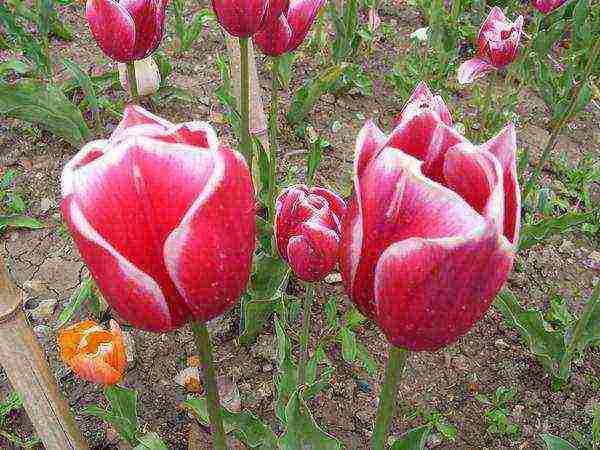
Tulip cultivar Lustige Witwe Strong stem 40-50 cm high, flower up to 8 cm high, cupped, dark crimson, with a white stripe along the edge of pointed petals. It blooms from the 2nd decade of April for 2 weeks. Resistant to weather surprises and diseases, but can be attacked by the variegated virus.
Tulip variety 'Alexander Puschkin'
Similar to the previous variety, a novelty of Dutch breeding. It has already been presented on the site earlier.
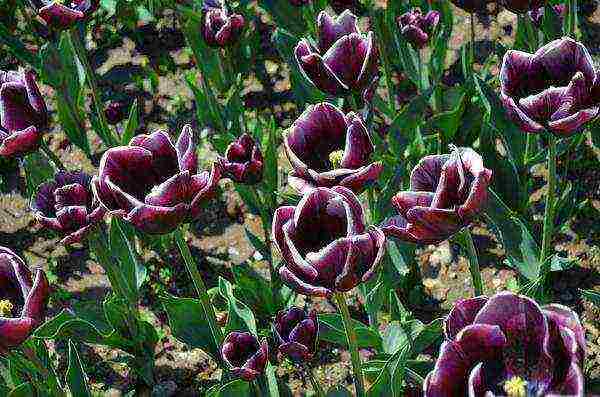
Tulip Alexander Puschkin cultivar Plant 40-45 cm high, sturdy stem, large flower, up to 8 cm high, maroon-purple, with a white border along the edge of the petals. Bloom more than 2 weeks. A very spectacular variety that will find its place in spring flower beds; suitable for forcing from January to March.
Tulip variety 'Mascara'
A luxurious variety - a novelty of the Dutch selection.
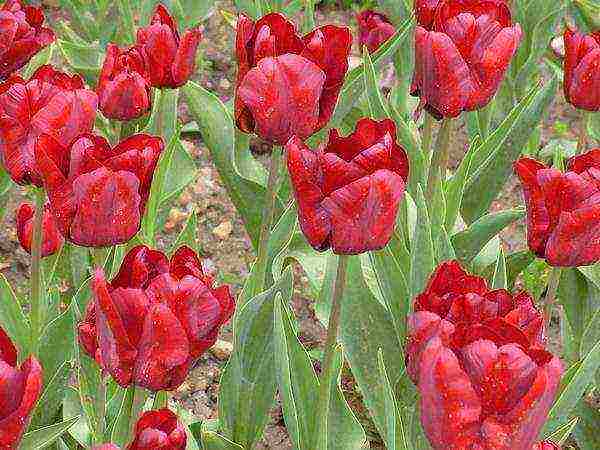
Tulip cultivar Mascara Plant 45-55 cm high, sturdy peduncle, goblet flower, up to 8 cm high, dark red. It blooms from the 3rd decade of April for 10 days. Resistant to adverse weather conditions. Good in flower gardens, where it creates bright spots in the spring; suitable for cutting and forcing in the winter-spring period (February-March).
Tulip cultivar 'Cancun'
A very beautiful variety.

Tulip Cancun cultivar Stem up to 60 cm high, strong. The goblet flower is large (up to 9 cm high), yellow, with a gradual transition to red. Resistant to winds and other weather troubles. It blooms from the 2nd decade of May. Good in mixborders, borders; stands perfectly in the cut.
Tulip cultivar 'Madame Curie'
This variety was created by the famous breeder Lefeber in 1944.
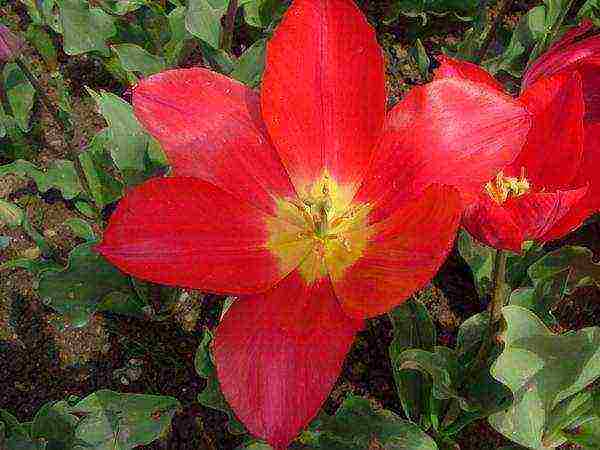
Tulip Madame Curie cultivar The cultivar is medium-sized, 50 cm high, the stem is strong. The flower is goblet, with pointed petals, up to 8 cm high, dark crimson. Dissolves from the 2nd decade of April; flowering up to 10 days. Resistant to diseases and adverse weather conditions.
Tulip variety 'Snowboard'
An exquisite variety with a strong peduncle up to 55 cm high.

Tulip Snowboard The flower is white, goblet, up to 6 cm high. It blooms in early May. You cannot do without such varieties when creating a white garden.
Tulip variety 'Grandma's fairy tales'
A domestic variety bred in Crimea by L.M. Alexandrova.
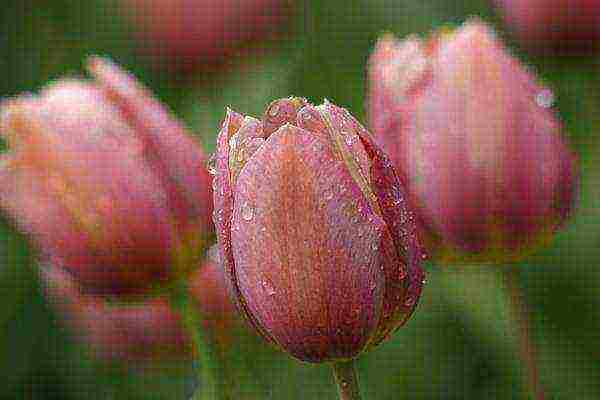
Tulip variety Granny's fairy tales, photo by A. Papkov Plant 50 cm high with a strong stem. The flower is goblet, up to 9 cm high, indescribable by the words of the color "faded grandmother's sundress". Blooms from 2-3 decades of April for 2 weeks. It tolerates well the high temperatures of the soil and dry winds that occur during the flowering period of plants, but in especially hot years, the duration of flowering can be reduced by 2-4 days. Resistant to diseases and pests, to adverse weather conditions. Self-sufficient in spring compositions, good in combination with tulip varieties and other spring-flowering bulbs. Suitable for cutting.
Tulip cultivar 'Orlenda'
This variety is a novelty of Dutch breeding. They predict a brilliant future for him, as they are considered one of the most promising.
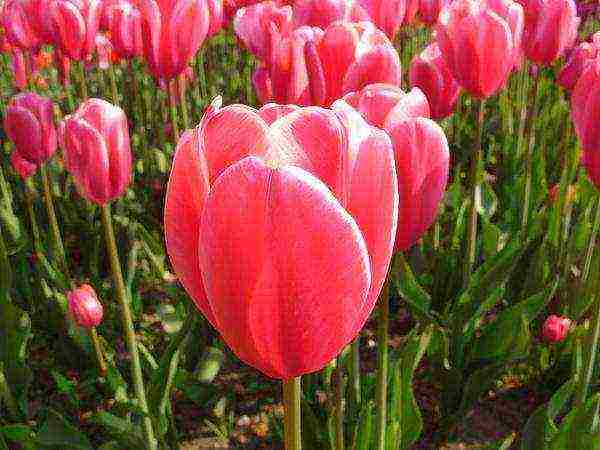
Tulip Orlenda cultivar Durable, up to 60 cm high. The flower is bright crimson, with a narrow white border along the edge of the petals.Good for forcing from February to March, well worth cutting.
Tulip 'Staning Apricot' cultivar
A popular cultivar with a sturdy flower stem, about 40 cm high.

Tulip Staning Apricot, photo by A. Papkov The flower is pink in the center of the petal, and apricot at the edges. A very effective variety! He is simply gorgeous in spring flower beds, borders; it can be grown in containers.
Tulip cultivar 'Anne Claire'
A lovely old-fashioned variety created by Coleen in 1958.
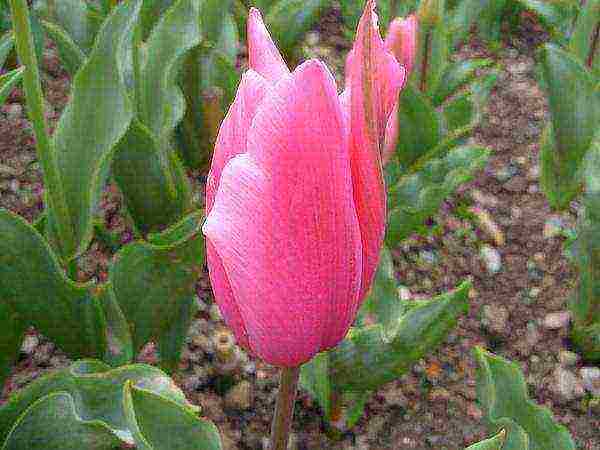
Tulip grade Anne Claire Plant 40-50 cm high; the peduncle is strong, the flower is goblet, up to 9 cm high, red-violet, with light lilac edges of the petals. It blooms in the 2-3 decade of April; duration - up to 10 days. Resistant to adverse weather conditions; can be affected by the variegated virus. Beautiful in spring in a wide variety of flower arrangements, suitable for cutting.
Tulip cultivar 'Preludium'
This variety was created by Koolen in the last year of the Great Patriotic War (1945).
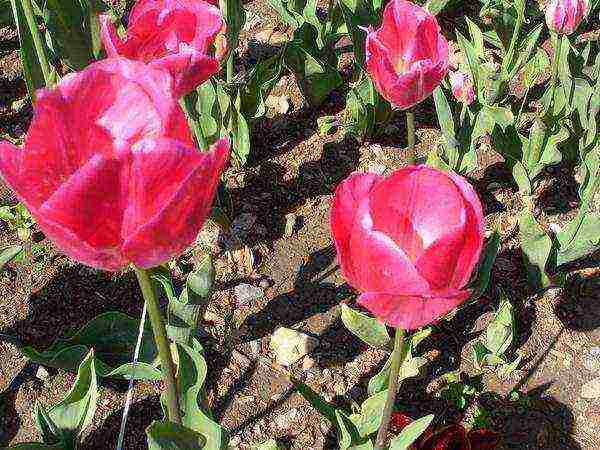
Tulip variety Preludium The stem is strong, 45 cm high. The flower is cup-shaped, large (up to 9 cm high), light pink, along the edge of the petal there is a wide lilac-pink stripe. Blooms from 2-3 decades of April, duration - up to 12 days. Resistant to diseases, but can be affected by the variegated virus; well resists weather whims. Suitable for cutting and forcing from January to March.
Tulip cultivar 'Tamara'
A very fashionable now white and red variety, created by Visser in 1979.
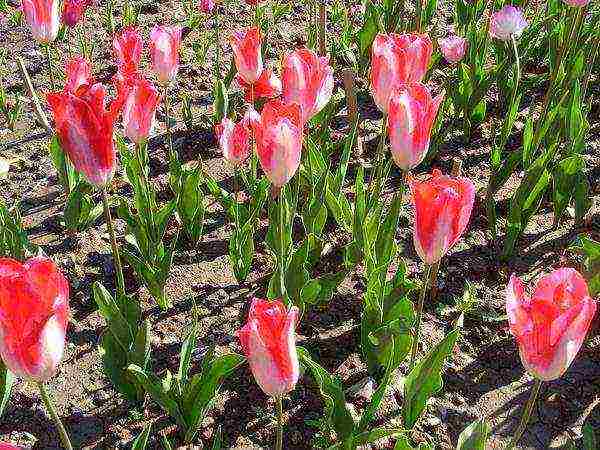
Tulip variety Tamara It is 40-50 cm high. The flower is goblet, large, up to 9 cm high, white, with a wide carmine-red strip along the edge of the petals. Blooms from 2-3 decades of April, flowering duration up to 12 days. Resistant to disease and weather. Good for cutting and forcing (January to March).
Tulip cultivar 'Emmy Peeck'
Historic variety created by Hybrida in 1949.
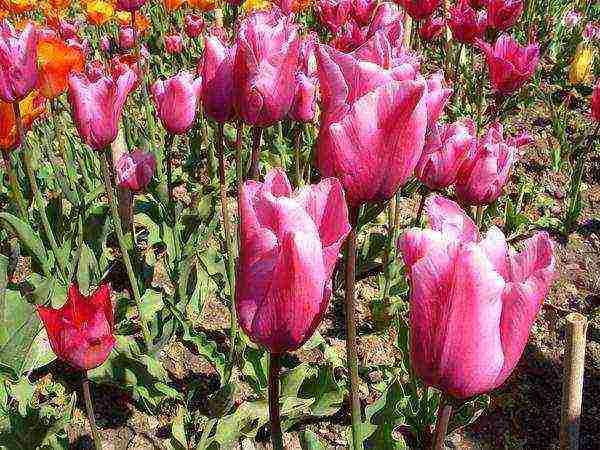
Tulip sort Emmy Peeck Plant 50 cm high. The flower is broadly goblet, large (up to 9 cm high), dark lilac-pink, with lighter edges of the petals. Flowering from the 3rd decade of April, lasting up to 17 days. May be affected by the variegated virus; resistant to bad weather. Good for cutting and in spring flower beds.
Tulip variety 'Pearl'
The domestic variety was created in the Crimea, co-author L.M. Alexandrova.
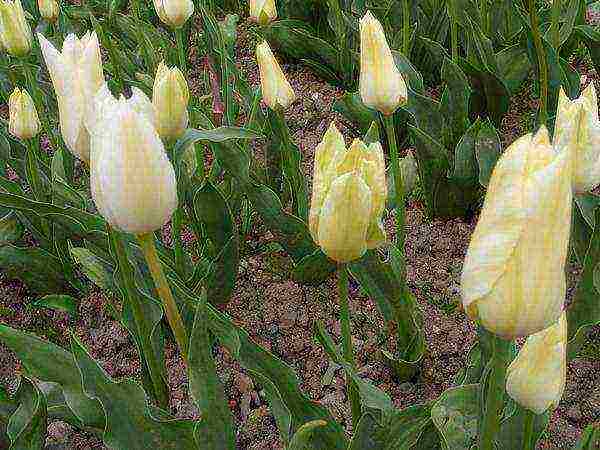
Tulip Pearl grade. The stem is strong, up to 50 cm high. The flower is goblet, 6-8 cm high, white-cream. Blooms from 2-3 decades of April for 2 weeks.
The nuances of tulip culture
- To prevent tulips from becoming smaller, they should be dug up annually.
- It is advisable to dig up the bulbs when the leaves turn yellow. Depending on the flowering period of various varieties, this is the second half of May or mid-June (in Crimea).
- After digging, the bulbs are dried in the shade, in a well-ventilated place, they are cleaned of old mother scales, the new crop is sorted by size and set for storage.
- To avoid the spread of diseases, the bulbs are treated with fungicides; it is useful to sprinkle them with colloidal sulfur.
- During storage, it is very important to observe the temperature regime, which regulates the passage of all organ-forming processes in the bulbs, determining the future flowering and the quality of new bulbs.
- Storage temperature should not exceed + 25 ° С.
Application
Tulips Triumph are good in the spring decoration of the local area, summer cottage, in various mixborders, on flower beds. Suitable for winter-spring forcing (from January to March inclusive) and for cutting.
* Blossoming dates are for the southern regions.

It is impossible to enumerate tulip varieties, there are an incredible variety of them - double late, fringed, undersized, peony, Dutch, for forcing and growing in a greenhouse - each of them will delight with their flowering, if the plant is properly cared for ...
Tulip varieties - New Dutch
![]() The tulip has long become a symbol of Holland - every year breeders present fresh varieties of Dutch tulips, although more than 2.5 thousand of them have already been bred in the Netherlands alone, and experienced gardeners have already got acquainted with the latest novelties:
The tulip has long become a symbol of Holland - every year breeders present fresh varieties of Dutch tulips, although more than 2.5 thousand of them have already been bred in the Netherlands alone, and experienced gardeners have already got acquainted with the latest novelties:
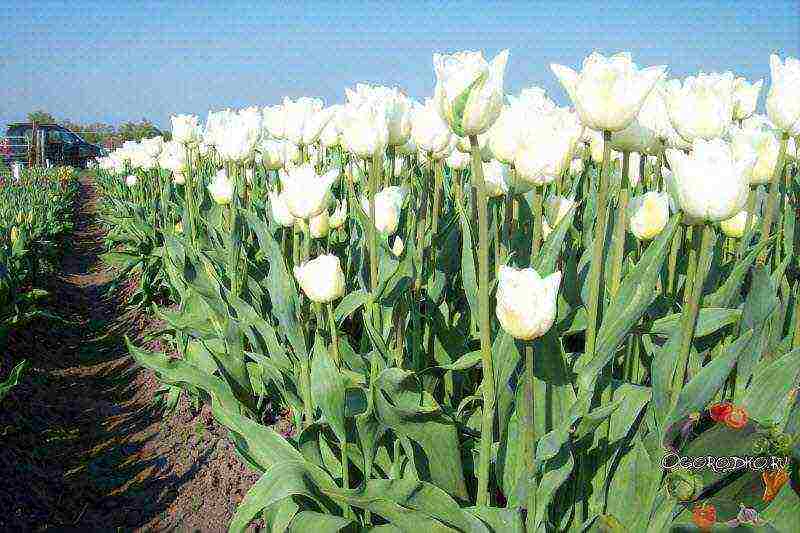 |
Albatross - snow-white, with a large graceful head, strong stem and dense leaves; |
 |
Beauty Trend - goblet, white, with a pink border, the stem reaches 70 cm; |
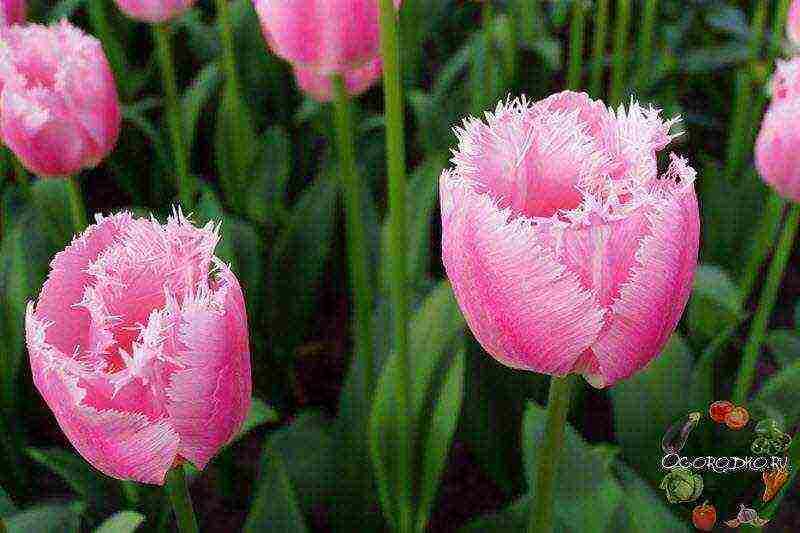 |
Casharel - intense pink glass with fringed edges; |
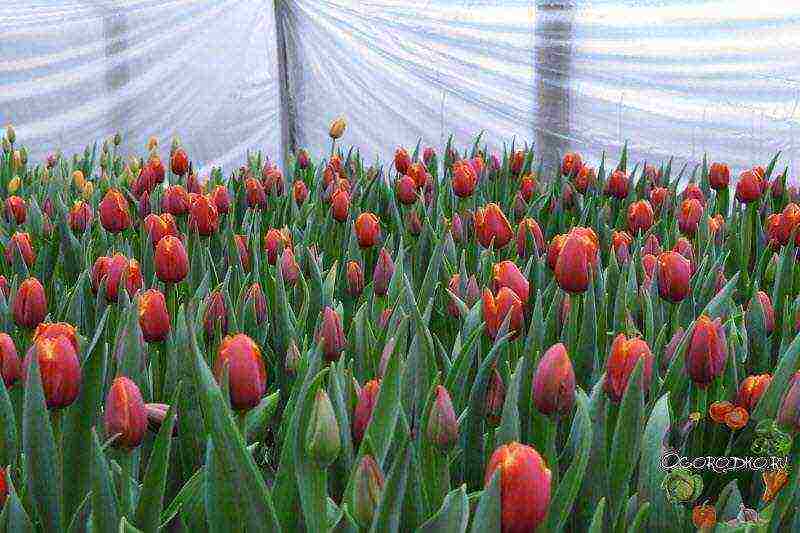 |
Verandi - harmoniously combines tomato red and sunny yellow tones with sharp transitions, the stem grows up to 55 cm. |
Ideal for forcing varieties - Darwin hybrids and Triumph
Tulips can bloom not only in spring, but in any month for the holiday, if they are grown according to the rules in a greenhouse or even at home - this method of growing is called forcing, and only special varieties of tulips can be successfully grown in this way.

tulips for distillation
For distillation, medium-flowering plants are optimal, first of all, of two classes - Darwin hybrids and Triumph:
Representatives of Darwin hybrids - goblet, impressive in size, with a diameter of more than 10 cm, on an 80-centimeter leg, - in the sun they open wide, like poppies, usually in red tones, but there are also two-color specimens;
Tulips Triumph have a goblet flower shape, can reach a height of 80 cm, as for color schemes, all colors and shades are present in the color palette of this class of tulips, with the exception of blue.
It is also worth highlighting the varieties of tulips for forcing in the greenhouse:
- Diplomat - bright pink with a blue-white center, the stem reaches 50-60 cm;
- Vivex - a large reddish-orange with yellow edges, elongated bud with a strong peduncle that does not open in the light;
Traditionally used for forcing tulip varieties Parade, Keys Nelis, Eric Hofsier.
Fringed tulips
Fringed tulips, the varieties and varieties of which appeared in Holland in the 30s of the XX century, got their name for the needle-like outgrowths along the edges of the petals, forming a fringe - they resembled a predatory plant sundew, this is how the name Sandyu is translated - the very first variety of this class, but recently, their multi-flowered varieties have also appeared:
The varieties of some fringed tulips are similar to lily-colored ones, in which three triangular inner petals are combined with reed outer ones - these are canary yellow Laverok, lemon Hamilton and others.
Double tulips - early and late varieties
Terry varieties are early and late. Early double tulips are undersized, their height does not exceed 30 cm, bloom at the end of April and delight the eye for a long time - they are planted in containers, they are excellent for forcing:
Late double tulips keep you waiting - they begin to bloom only in the second half of May. They are called pion-shaped, as they are sometimes indistinguishable from peonies - these luxurious creatures serve as a precious decoration of flower beds.
Terry late varieties show a variety of colors - from snowy white to very dark, there are also extremely expressive two-tone varieties. All of them look great on the alleys of parks and in gardens:
Spectacular varieties of this class are Virosa, Charmin Lady, Sunlaver, Black Hirow, Negritta Double, Blue Diamond, Orange Angelica, Ankle Tom Bonanza.
White peony tulips look especially airy - these are Mount Tacoma, Casablanca, Maureen Double, Denslane.
Low-growing tulips or dwarf
Dwarf varieties are distinguished by unprecedented endurance, they are not afraid of cold weather, drought, wind - they are the first to decorate flower beds, you can also use them for forcing. Dwarfs, whose height is no more than 10 cm, are varied in color - from pure white to dark purple, but they are especially striking in the variety of purple tones, among them there are pink, bright crimson, purple, carmine, cherry.
Low-growing tulips are diverse in shape - they can be double, lily-shaped, multi-flowered, and among the best varieties are:
Tulip varieties such as Rembrandt tulips, as if stained by the artist's brush, will become real treasures of your garden:
The world collection of varieties is constantly growing, and flowers are becoming more and more like works of art.
While fresh flowers can always be bought at a flower shop, making your own tulips is a special treat. To your attention - tulip varieties that are ideal for home cultivation.
Self-grown flowers that adorn the windowsill in winter or early spring - what else can also cheer you up in cold cloudy weather? Forcing tulips by March 8, Valentine's Day or even New Year's is not as difficult as it seems.
First, a little theory. One of the most important steps in forcing tulips is chilling. The container with the planted bulbs is placed in a cool place with an air temperature of 5-9 ° C so that the tulip goes through the so-called G (Ji) stage, during which the main parts of the plant are formed. The time it takes for the buds to bloom depends on how long the plant needs to cool down, and the duration of this period differs from species to species.
To calculate in what numbers to plant tulip bulbs for distillation, subtract about 13-19 weeks (cooling time) from the desired flowering date, plus another 3-4 weeks. Typically, tulip bulbs are planted for distillation in early to mid-October.
We have selected the most interesting tulip varieties suitable for distillation, and now we will tell you about them. Read and choose!
Apricot Parrot
| Class | Plant height | Color of petals | Cooling time (weeks) |
| Parrot | up to 70 cm | Apricot | 15-16 |
It seems as if in the bud of this tulip you can see all the shades of the sunset sky: apricot rays are beautifully scattered over as if ruffled petals. Such an unusual flower shape is a sign of the Parrot class. An interesting feature of "parrots" - their petals can be of almost any shape, except for the classic: wavy, twisted, split, crumpled. "Apricot parrot" will surely appeal to fans of exotic.
Blue Diamond
| Class | Plant height | Color of petals | Cooling time (weeks) |
| Terry | up to 40 cm | Purple violet | 15-16 |
The neatly formed double satin petals of the "blue diamond" (as the name of the variety is translated) look bright and bold. The deep color is mesmerizing, it is difficult to look away from it. Terry tulips are called peony tulips because their petals are layered on top of each other, forming a bud, similar to a peony flower. Blue Diamond is equally good for forcing and growing in a flower garden.
Blue Heron
| Class | Plant height | Color of petals | Cooling time (weeks) |
| Fringed | up to 60 cm | Lilac purple | 18-19 |
Members of the Fringed class have many fans. This is not surprising, because the petals, fringed with fringe, look like they are covered with frost. The shape of the petals of the Blue Heron tulip evokes associations with the silhouette of a heron (moreover, “blue heron” is a literal translation of the name of this variety). The shade goes from dark purple at the base of the bud to light purple at the edges of the petals.
Brigitta (Brigitta, Brigitte)
| Class | Plant height | Color of petals | Cooling time (weeks) |
| Triumph | up to 50 cm | Yellow with red "blush" | 13-14 |
This variety belongs to the popular Triumph class. Typical features of the representatives of Triumph: a clear goblet shape of the bud and a strong, high peduncle. This variety is no exception. The unusual coloring of Bridgette evokes the idea of a girlish blush: the petals resemble the flushed cheeks of a young modest girl.
Gander's Rhapsody
| Class | Plant height | Color of petals | Cooling time (weeks) |
| Triumph | up to 50 cm | Soft pink | 13-14 |
Tulips of this variety tend to change color over time. At first, only light streaks are visible in the deep pink bud.Then the base of the petal becomes milky white, and pink blotches are located a little higher, resembling small splashes. Gunders Rhapsody is suitable for those who prefer restraint and sensuality at the same time.
Hamilton (Hamilton)
| Class | Plant height | Color of petals | Cooling time (weeks) |
| Fringed | up to 80 cm | Bright yellow | 16-17 |
Yellow tulips are by no means the messengers of separation. The sun color affects a person extremely favorably: it is the color of optimism, energy, love of life. The variety of this fringed tulip bears the name of Lady Hamilton, a scandalous beauty who lived in Great Britain in the 18th-19th centuries. Bright buds with fringed petals look impressive and never go unnoticed, like the famous British woman.
Hemisphere
| Class | Plant height | Color of petals | Cooling time (weeks) |
| Triumph | up to 70 cm | White with pink strokes | 15-16 |
The Hemisphere tulip is the embodiment of tenderness and changeability at the same time. This is a chameleon flower. Look at its amazing color: at first, milky-white petals are covered with gradually emerging pale pink strokes, as if left by the brush of an unknown artist. Later, the bud begins to darken and turns dark pink.
Lucky Strike
| Class | Plant height | Color of petals | Cooling time (weeks) |
| Triumph | up to 60 cm | Red with white border | 13-14 |
Those who love contrasting color combinations (in this case, active red and snow-white) will surely appreciate the Lucky Strike tulip variety. The classic shape of the bud, inherent in all representatives of the Triumph class, does not look too strict due to the variegated color of the petals. The peculiarity of the variety is that the bud does not fully open during flowering.
Madison Garden
| Class | Plant height | Color of petals | Cooling time (weeks) |
| Fringed | up to 50 cm | Raspberry pink with yellowish fringes | 16-17 |
This tulip variety bears the name of the famous New York sports complex, which has become a venue for iconic sports events and concerts of world famous show business stars. Madison Garden tulips, graceful and solemn at the same time, with their unusual fringed petals resemble a bright stage costume of the artist. If you want a holiday in your heart, be sure to try growing these tulips!
White Elegance
| Class | Plant height | Color of petals | Cooling time (weeks) |
| Lily-colored | up to 60 cm | Creamy white | 15-16 |
A distinctive feature of the lily-colored class, as it is not difficult to guess, is the similarity of shape with a lily bud. The White Elegance tulip is really elegant and looks very noble. The ivory-tinted petals, pointed at the ends, resemble miniature daggers. If you are an adherent of rigor and stylish solutions, decorate the interior of the apartment by growing such a tulip at home.
Having told about the varieties of tulips that are ideal for forcing, we, of course, cannot ignore the very technology of this fascinating process. Especially for you - our master class on forcing tulips at home:
A little more and the gray winter sky will change its color to a more joyful one - spring blue. And this means that it is time to present all the bright colors of your garden now. Those who did not manage to plant bulbous plants in autumn can do it now. This article will tell you about your favorite bulbs like tulips. More precisely, we offer 6 varieties - favorites for decorating the spring look of the site. They belong to different groups.
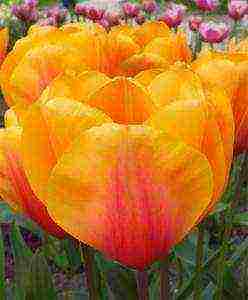 Cash - a tulip variety from the group of Darwin hybrids. The flower is yellow with red strokes. The size of the flower tulip Cash Tulip is 6 cm in height and 4 cm in diameter. The plant itself grows up to 65 cm. The tulip begins to bloom from late April - early May. The bulb produces many babies - accordingly, the plant reproduces well.This tulip variety is recommended for distillation in February-March in bouquets. It tolerates spring frosts well, is resistant to the variegated petal virus and retains its attractiveness in a vase for a long time. It smells very nice and rich. Similar varieties Crossfire, Striped Bellona, Andre Citroen, Falcon, Hennie van de Most, Apeldoom's Elite, Sahara Rally, World's Peace, Seneada Orange, Canary, Davenport. They are all from different groups, but with a similar coloration.
Cash - a tulip variety from the group of Darwin hybrids. The flower is yellow with red strokes. The size of the flower tulip Cash Tulip is 6 cm in height and 4 cm in diameter. The plant itself grows up to 65 cm. The tulip begins to bloom from late April - early May. The bulb produces many babies - accordingly, the plant reproduces well.This tulip variety is recommended for distillation in February-March in bouquets. It tolerates spring frosts well, is resistant to the variegated petal virus and retains its attractiveness in a vase for a long time. It smells very nice and rich. Similar varieties Crossfire, Striped Bellona, Andre Citroen, Falcon, Hennie van de Most, Apeldoom's Elite, Sahara Rally, World's Peace, Seneada Orange, Canary, Davenport. They are all from different groups, but with a similar coloration.
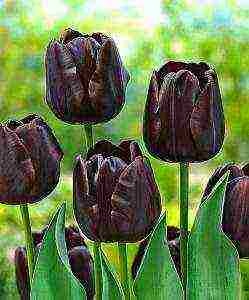 Paul scherer - a tulip from the Triumph tulip group, blooming from the end of April to the beginning of May. The height of the plant varies from 30 to 50 cm. The flower can be 8-10 cm high. The foliage is gray-green. This is also a cut tulip. Similar varieties of this bulbous variety - Black Hero, Parrot Negrita, Frozen Night, Black Parrot, Labrador, Gorilla, Cuban Night, Bulldog, Queen of Night, Ronaldo, Black Star, Black Jack, Palmyra, Black Beauty, Black Horse, Black Pearl, Café Noir, Continental. There are different tulips from different groups on this list, but they are united by color.
Paul scherer - a tulip from the Triumph tulip group, blooming from the end of April to the beginning of May. The height of the plant varies from 30 to 50 cm. The flower can be 8-10 cm high. The foliage is gray-green. This is also a cut tulip. Similar varieties of this bulbous variety - Black Hero, Parrot Negrita, Frozen Night, Black Parrot, Labrador, Gorilla, Cuban Night, Bulldog, Queen of Night, Ronaldo, Black Star, Black Jack, Palmyra, Black Beauty, Black Horse, Black Pearl, Café Noir, Continental. There are different tulips from different groups on this list, but they are united by color.
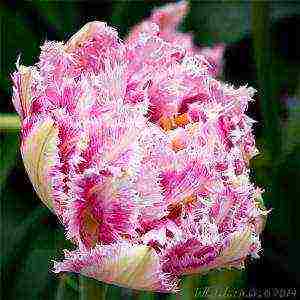 Cool crystal - a fringed terry tulip with a very interesting color - crimson, creamy, deep pink and splashes of yellow on the petal and a white transparent and shining edge made of crystal fringe. The size of the spherical flower is 12 cm in diameter. Plant height - 30-45 cm. It blooms in mid-spring. Tulip varieties similar in color - Russian Princess, Virichic, Dallas, Apricot Parrot, Parrot Lady, Air, Anna Roose. The selection of these tulip varieties was carried out in different groups.
Cool crystal - a fringed terry tulip with a very interesting color - crimson, creamy, deep pink and splashes of yellow on the petal and a white transparent and shining edge made of crystal fringe. The size of the spherical flower is 12 cm in diameter. Plant height - 30-45 cm. It blooms in mid-spring. Tulip varieties similar in color - Russian Princess, Virichic, Dallas, Apricot Parrot, Parrot Lady, Air, Anna Roose. The selection of these tulip varieties was carried out in different groups.
 Blueberry Ripple® - a two-color tulip from the Triumph tulip group. This cultivar is blessed with wonderful fragrant white flowers with purple stripes extending widely from the base and tapering towards the top. The height of the plant is 45 cm, and the size of the flower is 7-12 cm in diameter. The tulip blooms from late April - early May. The flower is cut for 10 days. The color of the foliage is green with an aquamarine tint. Like all tulips and bulbous plants in particular, it can be grown in container culture. The planting depth of tulip bulbs depends on their size and can vary from 8 cm to 15 cm. Similar varieties - Jackpot, Jacuzzi, Rem's Favorite, Flaming Flag, Rajka, Duc van Tol Violet, Flaming Flag, Hot Pants, Salvation Army, Beauty of Volendam, Success, Blue Eyes, Arabian Mystery, Twin Flame, Shirley Flame, Madame Butterfly, Ronald Gunn, Black and White, Adonis (Rembrandt), Blue Diamond, Double Shirley. Among these tulip varieties, there are tulips from different groups, with a more intense color or weaker.
Blueberry Ripple® - a two-color tulip from the Triumph tulip group. This cultivar is blessed with wonderful fragrant white flowers with purple stripes extending widely from the base and tapering towards the top. The height of the plant is 45 cm, and the size of the flower is 7-12 cm in diameter. The tulip blooms from late April - early May. The flower is cut for 10 days. The color of the foliage is green with an aquamarine tint. Like all tulips and bulbous plants in particular, it can be grown in container culture. The planting depth of tulip bulbs depends on their size and can vary from 8 cm to 15 cm. Similar varieties - Jackpot, Jacuzzi, Rem's Favorite, Flaming Flag, Rajka, Duc van Tol Violet, Flaming Flag, Hot Pants, Salvation Army, Beauty of Volendam, Success, Blue Eyes, Arabian Mystery, Twin Flame, Shirley Flame, Madame Butterfly, Ronald Gunn, Black and White, Adonis (Rembrandt), Blue Diamond, Double Shirley. Among these tulip varieties, there are tulips from different groups, with a more intense color or weaker.
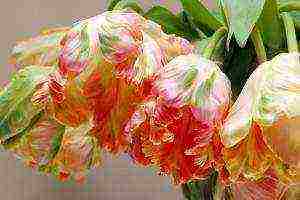
parrot tulips
Parrot Is a group of parrot tulips that is gaining more and more popularity. They are bright, colorful, catchy. They have not only interesting colors, but also the shape of the petals is amazing: like bird feathers - sometimes straight, sometimes pretentiously curved in some place. The number of petals is different, depending on the variety. Their color can be monochromatic and different. Among them there are fringed ones. Some bloom in mid-spring, some bloom in late spring. The height of these tulips is up to 50 cm. The only "but" of these bulbous plants is that they are planted in places protected from strong gusts. Parrot tulips - Glasnost, Apricot Parrot, Bastogne Parrot, Blue Parrot, Blumex, Flaming Parrot, Garden Fire, Monte Parrot, Sexy Lady, Silver Parrot, Anelias, Amiral de Constantinopel, Anna Magnani, Bariton, Black Parrot, Blumex Favorite, Bright Parrot , Caland, Comet, Cramoise Brilliant Parrot, Destiny, Diamond Parrot, Discovery, Doorman's Record, Faraday, Rai, Firebird, Rococo Orange, Rococo Dark, Feathered beauty, Zampa Parrot, James Last, Libretto Parrot, Lutea Major, Madonna, Markgraaf, Muriel, Negrita Parrot, Red Cap, Rococo, Super Parrot, Texas Fire, Texas Flame, Texas Gold, White Parrot, Yellow Sun, Chicago, Double Flaming Parrot, Fantasy, Princess Irene Parrot, Yoko Parrot, Topparrot, Amethyst, Avignon Parrot, Black Parrot, Bright Parrot, Caprice, Double Fantasy, Estella Rijnveld, Air, Ho Tcho, Ivory Parrot, James V Forrestal, Karl Doorman, Klara Park, Moderato, Onedin, Orange Favorite, Professor Rontgen, Monarch Parrot, Eagle Wings, Marcia, Maria de Silva, Marvel Parrot , Master Parrot, Parrot Inzell, Pioneer, Surprise Parrot, Anna Magnani, Fresh Air, Gander Parrot, Prince Parrot, Frozen Night, Parrot Fire Queen, Winter Parrot.
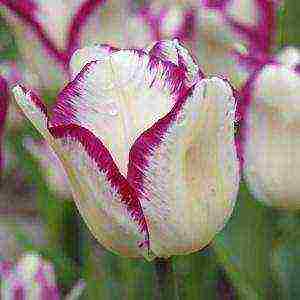 Affaire - early blooming tulip from Darwin hybrids. The main color is white, and along the edge of the petal there is a purple stripe pattern. Plant height - 45-50 cm, flower size - 10-15 cm in a fully unfolded state. He prefers llight, neutral, loamy soils, slightly sandy... However, these types of soil are preferred for all tulips... This tulip variety reproduces well and produces an excellent distillation for the bouquet business. The group to which he belongs is the Triumph tulips.
Affaire - early blooming tulip from Darwin hybrids. The main color is white, and along the edge of the petal there is a purple stripe pattern. Plant height - 45-50 cm, flower size - 10-15 cm in a fully unfolded state. He prefers llight, neutral, loamy soils, slightly sandy... However, these types of soil are preferred for all tulips... This tulip variety reproduces well and produces an excellent distillation for the bouquet business. The group to which he belongs is the Triumph tulips.


